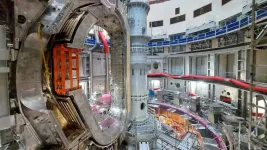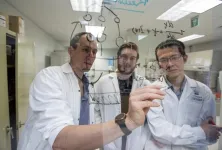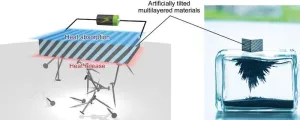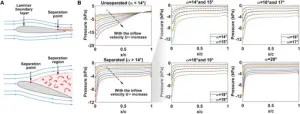(Press-News.org) As researchers around the world work to develop viable alternatives to fossil fuels, the prospect of nuclear fusion—harnessing the same energy-generating reactions that power the sun—has grown increasingly attractive to private equity firms.
In 2022, the U.S. Department of Energy launched a partnership with investors in the private sector to accelerate the development of fusion energy, in part through the development of a fusion pilot plant, or FPP, in the United States.
The FPP and ITER—the world’s largest nuclear fusion reactor, currently being built in France—represent the future of fusion, according to Eugenio Schuster, a professor of mechanical engineering and mechanics in Lehigh University’s P.C. Rossin College of Engineering and Applied Science. Ensuring that future is a success, however, requires the reactors to operate within safety, stability, and controllability boundaries, he says.
Schuster, who directs the Lehigh University Plasma Control Group, recently received a $1.6 million grant from the DOE to conduct experiments on the DIII-D National Fusion Facility in San Diego that will ultimately serve to improve the operation of ITER, FPP, and future reactors through the development of advanced controls and the application of machine learning.
The three-year grant is part of a $16 million DOE initiative to fund projects focused on advancing innovative fusion technology and collaborative research on small-scale experiments and on the DIII-D tokamak. The DIII-D tokamak is a device designed not to produce energy, but to help researchers study the physics of the plasma where energy-releasing fusion reactors would take place and develop the technology that is needed for reactor operation.
“There are two goals with this project,” says Schuster. “The first is to improve the operation of DIII-D itself, and the second is to address the technological issues that we’ll be facing with both ITER and FPP.”
Those issues are myriad and exceedingly complex. For one, researchers like Schuster cannot study the type of plasma, called burning plasma, that will be present in fusion reactors.
“In devices like DIII-D, we create a very hot gas in a plasma state, and the goal is to study the physics of that plasma and how to stably confine it,” he says. “But this is not the type of gas that we’re going to use in ITER or in FPP. In fact, the employed gas lowers the probability of fusion in DIII-D instead of increasing it. We don’t want to have nuclear fusion reactions in these experimental devices because then everything becomes radioactive and it becomes much more complicated to carry out experiments.”
Instead, researchers must develop the tools they’ll ultimately need to control the burning plasma of a reactor like ITER or FPP, on a test bed like DIII-D. Using DIII-D, the team will emulate the conditions of an actual nuclear reactor to better understand the dynamics of the plasma and to develop the necessary control solutions. These solutions will ultimately be extrapolated to ITER or FPP by following a model-based approach.
“You have three key elements in the control design,” he says. “One is the control algorithm, or the controller, and that’s what we work on in my group. Based on plasma-response models, we develop algorithms that will keep the plasma dynamics stable and reach the level of performance needed in reactor operation. The other two elements are the actuators, which can modify the dynamics, and the sensors that are your eyes, basically, into what’s happening.”
His team needs to develop algorithms that are smart enough to indicate to the actuators when priorities change. For example, if an actuator is being used to control the temperature of the plasma, but a sudden instability occurs that could cause what Schuster half-jokingly describes as a “poof”—when the hot gas is no longer confined and hits the inner wall of the reactor with all the force of a small earthquake—the algorithm needs to indicate to the plant supervisor that temperature is no longer relevant. The actuator must be repurposed to stabilize the plasma.
“It’s important that the algorithms that we expect to prove on DIII-D can be extrapolated to these other machines,” he says. “They cannot fail. This poof can never happen. The plasma inside ITER and FPP will be 100 million degrees Celsius, and if gas that hot becomes unconfined, it can really damage the reactor. So we have to develop these control algorithms for a machine that cannot fail, but we can’t do any experimentation with that machine.”
He stresses that all the problems inherent in such a challenge won’t be solved within a three-year project. But the work will move the state-of-the-art in incremental yet meaningful steps forward.
Another goal of the project is to bring more researchers into the field of nuclear fusion energy. The workforce necessary for progress hasn’t kept up with the increasing interest in fusion and the nascent nuclear-fusion industry, says Schuster, and the grant will support four PhD students who will all eventually work in San Diego as part of their doctoral program.
“There are several Lehigh graduates who are now a part of the permanent staff at the DIII-D National Fusion Facility,” he says. “A key part of this project is developing the human resources for the next generation of tokamaks that we plan on building.”
He says it’s an exciting time to be in the field. Advances in magnet technology, materials, computational processing, and machine learning—combined with substantial public and private investment—are all bringing the dream of limitless, clean energy a bit closer to reality.
“If I didn’t believe in it, I wouldn’t be working on it,” he says. “I’m feeling optimistic that it will, eventually, happen.”
END
Smooth operation of future nuclear fusion facilities is a matter of control
The Lehigh University Plasma Control Group, supported by a new $1.6 million DOE grant, continues work on advancing plasma dynamics simulation capabilities and algorithms to control superheated gasses that hold promise for limitless, clean energy
2024-01-16
ELSE PRESS RELEASES FROM THIS DATE:
Microfossils shed light on the long fossil record of euglenoids
2024-01-16
Hiding in the shadows, euglenoids are a fascinating group of single-celled protists that are neither plant nor animal. Plants photosynthesize, and animals eat. Euglenoids do both. Spiraling along the murky bottoms of shallow fresh-water ponds with their long flagella, they eat organic goop, while also using their chloroplasts to convert CO2 and water with light into sugars. Because of this in-between status, euglenoids have been placed close to the very base of the eukaryotic branch on the tree-of-life that includes ...
Amnesia caused by head injury reversed in early mouse study
2024-01-16
WASHINGTON - A mouse study designed to shed light on memory loss in people who experience repeated head impacts, such as athletes, suggests the condition could potentially be reversed. The research in mice finds that amnesia and poor memory following head injury is due to inadequate reactivation of neurons involved in forming memories.
The study, conducted by researchers at Georgetown University Medical Center in collaboration with Trinity College Dublin, Ireland, is reported January 16, 2024, in the Journal of Neuroscience.
Importantly for diagnostic and treatment purposes, the researchers found that the memory loss attributed to head injury was not a permanent pathological event driven by ...
Domesticating plants impacts their microbiome, study finds
2024-01-16
New research led by the University of Oxford indicates that human domestication of crops can alter the communities of microorganisms that are associated with plants. Intriguingly, independent domestication events were found to have similar impacts on the plant microbiome. The results have been published today in Current Biology.
Lead researcher Dr Riccardo Soldan (Department of Biology, University of Oxford) said: 'Our study provides evidence that regardless of where and how domestication took place, domesticated ...
Reductive carboxylation of glutamine as a potential target in AML
2024-01-16
“Identification and validation of novel and targetable metabolic weaknesses in AML is ongoing.”
BUFFALO, NY- January 16, 2024 – A new editorial paper was published in Oncotarget's Volume 14 on December 1, 2023, entitled, “Reductive carboxylation of glutamine as a potential target in acute myeloid leukemia.”
In this new editorial, researchers Alessia Roma, Lawrence D. Goodridge and Paul A. Spagnuolo from the University of Guelph discuss acute myeloid leukemia (AML) — an aggressive cancer of the blood and bone marrow ...
Identity concealment in sexual minority men may have impeded mpox care
2024-01-16
ITHACA, N.Y. – Openly gay, bisexual and other sexual minority men were more likely than those who conceal their sexual orientation to seek care for mpox during a global outbreak of the disease last year that disproportionately affected their community, researchers from Cornell University and the University of Toronto found.
It wasn’t necessarily concern over being “outed” that kept some sexual minority men from seeking care for the disease, formerly known as monkeypox. According to the researchers, it was an information gap, partially attributable to separation from community due to identity concealment.
“The resource knowledge and community-connected ...
BSC predicts that global-mean temperature could reach the 1.5ºC warming level threshold in 2024
2024-01-16
2023 has just been confirmed as the hottest year on record, with global average temperatures exceeding pre-industrial conditions by 1.48°C, as stated by the Copernicus Programme of the European Union. Climate scientists from the Barcelona Supercomputing Center-Centro Nacional de Computación (BSC-CNS), based on the BSC decadal forecast system, were capable of predicting a year ago that 2023 had a high probability of being the warmest year on record.
After the record-smashing conditions in 2023, the imminent question is how the year 2024 and the following years will ...
New study aims to unlock secrets of the human brain
2024-01-16
The inner workings of the human brain are a gradually unraveling mystery and Dr. Richard Naud of the University of Ottawa’s Faculty of Medicine has led a highly compelling new study that brings us closer to answering these big questions. The study’s results have important implications for theories of learning and working memory and could potentially help lead to future developments in artificial intelligence (AI) since AI developers and programmers watch the work of Dr. Naud and other leading neuroscientists.
Published in Nature Computational Science, the study tackles the many-layered mystery ...
Pudukotai Dinakarrao studying ways to protect autonomous vehicle supply chains
2024-01-16
Sai Manoj Pudukotai Dinakarrao, Assistant Professor, Electrical and Computer Engineering, received funding for the project: "Cyber Sentinel: Safeguarding Autonomous Vehicle Supply Chains against Backdoors in Hardware."
Pudukotai Dinakarrao is working with University of Virginia researchers who aim to deploy a backdoor attack mitigation and avoidance approach for vehicles.
Haiying Shen, Associate Professor, Computer Science; Associate Professor, Electrical and ...
Thermoelectric permanent magnet opens new possibilities in thermal management technologies
2024-01-16
1. A NIMS research team has demonstrated that the transverse thermoelectric conversion (i.e., energy conversion between charge and heat currents that flow orthogonally to each other) can be greatly enhanced by applying magnetic fields or utilizing magnetism. In addition, the team developed a thermoelectric permanent magnet—a new functional material capable of thermoelectric cooling and power generation—by combining permanent magnets and thermoelectric materials into a hybrid structure. These results may guide in achieving thermal ...
Quantum computing and machine learning are effective tools in fluid dynamics
2024-01-16
To prevent aircraft stalls, engineers have long studied the flow of air over airfoils such as airplane wings to detect the angles when flow separation occurs. Recently, a team of researchers at Shanghai Jiao Tong University including Xi-Jun Yuan and Zi-Qiao Chen investigated the use of quantum computing in connection with machine learning as a more accurate way of solving such problems. Their research was published Nov. 21 in Intelligent Computing, a Science Partner Journal.
The use of a quantum support vector machine rather than a classical support vector machine increased the accuracy of classification of flow separation from 81.8% ...
LAST 30 PRESS RELEASES:
Heart-brain connection: international study reveals the role of the vagus nerve in keeping the heart young
Researchers identify Rb1 as a predictive biomarker for a new therapeutic strategy in some breast cancers
Survey reveals ethical gaps slowing AI adoption in pediatric surgery
Stimulant ADHD medications work differently than thought
AI overestimates how smart people are, according to HSE economists
HSE researchers create genome-wide map of quadruplexes
Scientists boost cell "powerhouses" to burn more calories
Automatic label checking: The missing step in making reliable medical AI
Low daily alcohol intake linked to 50% heightened mouth cancer risk in India
American Meteorological Society announces Rick Spinrad as 2026 President-Elect
Biomass-based carbon capture spotlighted in newly released global climate webinar recording
Illuminating invisible nano pollutants: advanced bioimaging tracks the full journey of emerging nanoscale contaminants in living systems
How does age affect recovery from spinal cord injury?
Novel AI tool offers prognosis for patients with head and neck cancer
Fathers’ microplastic exposure tied to their children’s metabolic problems
Research validates laboratory model for studying high-grade serous ovarian cancer
SIR 2026 delivers transformative breakthroughs in minimally invasive medicine to improve patient care
Stem Cell Reports most downloaded papers of 2025 highlight the breadth and impact of stem cell research
Oxford-led study estimates NHS spends around 3% of its primary and secondary care budget on the health impacts of heat and cold in England
A researcher’s long quest leads to a smart composite breakthrough
Urban wild bees act as “microbial sensors” of city health.
New study finds where you live affects recovery after a hip fracture
Forecasting the impact of fully automated vehicle adoption on US road traffic injuries
Alcohol-related hospitalizations from 2016 to 2022
Semaglutide and hospitalizations in patients with obesity and established cardiovascular disease
Researchers ‘listen in’ to embryo-mother interactions during implantation using a culture system replicating the womb lining
How changing your diet could help save the world
How to make AI truly scalable and reliable for real-time traffic assignment?
Beyond fragmented markets: A new framework for efficient and stable ride-pooling
Can shape priors make road perception more reliable for autonomous driving?
[Press-News.org] Smooth operation of future nuclear fusion facilities is a matter of controlThe Lehigh University Plasma Control Group, supported by a new $1.6 million DOE grant, continues work on advancing plasma dynamics simulation capabilities and algorithms to control superheated gasses that hold promise for limitless, clean energy








